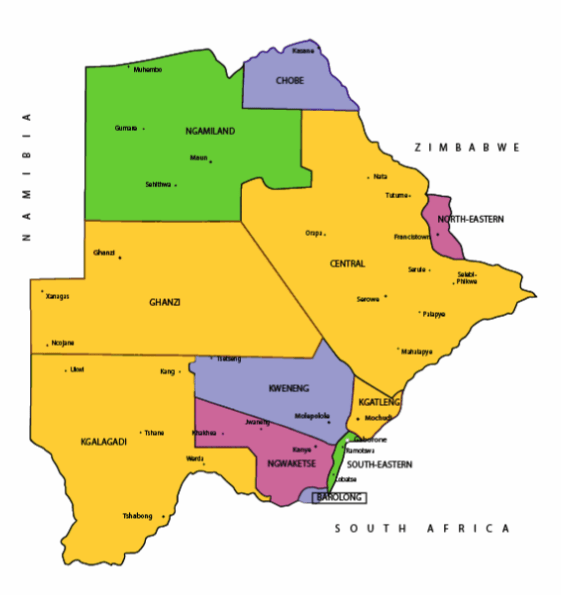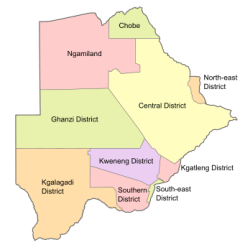Places and their polling stations in Kanye North, Botswana
409 Gasegogwane
1921 Modise Primary School
1922 Moshana Kgotla
1923 Matlotlakgang Primary School
1924 Losabanyana Open Space
1925 Molapowaditau
410 Kgosing
1926 Mathiba JSS
1927 Bome Kgotla
1928 Mokgadi Primary School
1929 Phitshane Kgotla
1930 Pwd Tent
1931 Main Kgotla
1932 Mmapatsane Kgotla
411 Bagami
1933 Rachele Primary School
1934 Sepojane
1935 Goora Kgama Kgotla
412 Dilolwe
1936 Lobeko Kgotla
1937 UCCSA (James Good) Church
1938 Dikgageng Kgotla
1939 Sebako Primary School
1940 Matsaakgang Primary School
413 Ranaka
1941 Ranaka Primary School
1942 Goo-Rra Sebubi Kgotla
1943 Kgosing
414 Mafhikana
1944 Tlhomo JSS
1945 Mosielele Kgotla
1946 Mafhikana Clinic
415 Kebuang
1947 Seno Kgotla
1948 Maloma-Ka-Tsejwana
1949 Kebuang Kgotla
416 Ntlhantlhe-Lekgolobotlo
1950 Ntlhantlhe Primary School
1951 Ntlhantlhe Kgotla
1952 Lekgolobotlo Primary School
1953 Potsane
1954 Rakgokonyane
1955 Mmaditlhake VDC
417 Magotlhwane-Kgomokasitwa
1956 Magotlhwane Primary School
1957 Magotlhwane Kgotla
1958 Emang JSS
1959 Kgomokasitwa Primary School
1960 Kgomokasitwa Kgotla
1961 Mmamonkge VDC House
Reference: iec.gov.bw/index.php/electoral-districts/polling-stations.html
Botswana
Botswana is a country in Africa. It is topographically flat, with approximately 70 percent of its territory being the Kalahari Desert.
It is bordered by South Africa to the south and southeast, Namibia to the west and north, and Zimbabwe to the northeast.
Capital: Gaborone
Currency: Botswanan Pula
Official language: English
Population: 2.588 million (2021) World Bank
Dialing code: +267
Gross Domestic Product: 17.61 billion USD (2021) World Bank
Botswana’s ten districts are:
- Southern District
- South-East District
- Kweneng District
- Kgatleng District
- Central District
- North-East District
- Ngamiland District
- Kgalagadi District
- Chobe District
- Ghanzi District
Botswana’s councils created from urban or town councils are: Gaborone City, Francistown, Lobatse Town, Selebi-Phikwe Town, Jwaneng Town, Orapa Town and Sowa Township.






The name Botswana refers to ‘Land of the Tswana’. The landlocked, Southern Africa country is officially known as the Republic of Botswana.














Botswana is connected to Zambia through the Kazungula Bridge making it the world’s shortest border between two countries.
A country of slightly over 2 million people (2021), Botswana is one of the most sparsely populated countries in the world. It is essentially the nation state of the Tswana ethnic group, who make up 79% of the population.

About 11.6 per cent of the population lives in the capital and largest city, Gaborone.
Formerly one of the world’s poorest countries—with a GDP per capita of about US$70 per year in the late 1960s—it has since transformed itself into an upper-middle-income country, with one of the world’s fastest-growing economies.


The Tswana ethnic group were descended mainly from Bantu-speaking tribes who migrated southward of Africa to modern Botswana, living in tribal enclaves as farmers and herders.




In 1885, the British colonised the area and declared a protectorate under the name of Bechuanaland.
As colonisation stopped, Bechuanaland became an independent republic under its current name on 30 September 1966.


Since then, it has been a representative republic, with a consistent record of uninterrupted democratic elections and the lowest perceived corruption ranking in Africa since at least 1998.

The economy is dominated by mining and tourism. Botswana has a GDP (purchasing power parity) per capita of about $18,113 as of 2021, one of the highest in subsaharan Africa.


Botswana is the world’s biggest diamond producing country.
Its relatively high gross national income per capita gives the country a high standard of living and the third-highest Human Development Index of continental Sub-Saharan Africa (after Gabon and South Africa).
The country has been adversely affected by the HIV/AIDS epidemic. In 2002, Botswana began offering anti-retroviral drugs (ARVs) to help combat the epidemic.
Botswana is a member of the Southern African Customs Union, the Southern African Development Community, the Commonwealth of Nations, and the United Nations.
